Horror films - 2016
| Ouija: Origin of Evil | Blair Witch | Don't Breathe |
| The Conjuring 2 | The Witch |
____________________
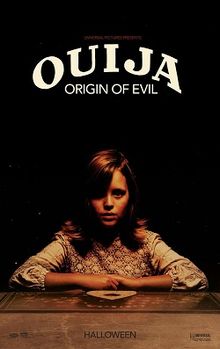 |
After the somewhat disappointing Ouija from 2014, Universal Studios follows up with a prequel, Ouija: Origin of Evil. This time, Mike Flanagan (Oculus) was brought in to write and direct, with more favorable results.
The story sets up the history of the spirits depicted in Ouija. Widow, Alice Zander (Elizabeth Reaser), conducts staged séances in her home to support herself and her two daughters. She purchases a Ouija board to add to the act and then discovers that her youngest daughter, Doris (Lulu Wilson), is actually able to communicate with spirits by using it. While Alice sees this as a miracle and a chance to actually provide a valuable service to people, she doesn't realize the true nature of the forces they are communicating with nor their actual intent. Things rapidly go downhill for everyone after that.
While the story seems a bit weak, the performances of Reaser, Wilson, and Annalise Basso as the older daughter, Lina, are actually quite good. It was also nice seeing Henry Thomas (E.T) in a heroic adult role.
Ouija: Origin of Evil has some decent scares, but after all, it's a horror movie based on a party game. One should only expect so much.
- JC
____________________
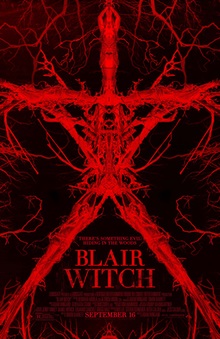 |
The Blair Witch Project (1999), told the story of three young film-makers who explore a wooded area in Maryland as they make a documentary about the “Blair Witch,” a local legend associated with grisly deaths and bizarre sightings over the course of 200 years. Although purely fictional, the film was promoted on the SciFi channel with a “documentary” about the Blair Witch legend. There was actually some confusion as to whether this story was fiction or not. The film was an early example of the found footage film-making format and is likely the main reason it became so often used thereafter. The film received both critical and audience acclaim as one of the most effective horror films of all time and grossed nearly $250 million at a cost of $60,000.
Why was this film so effective? It seemed real. The people seemed real. The clumsy, amateurish shaky video seemed real. Their time in the woods seemed real. And more – if one has ever had anything eerie or seemingly supernatural occur in their experience, it is rarely clear. It is glimpsed. Evidence is found, but the cause is not. It may even deepen the dread. Something is near. Something you can’t touch or understand. It’s coming for you. And nothing you do can prevent it. In The Blair Witch Project, our characters slowly lose hope, like a fly slowly realizing what it is clinging to is a web. It may never even see the spider, but it knows it’s there.
Blair Witch tries to recreate some of this formula and it succeeds in some ways. We have six seekers this time, but they are three fairly attractive young couples. There is a back-story – James (James Allen McCune) is the younger brother of Heather from the original film. Because of some video he saw online, he thinks his sister could still be alive. So, armed with a belief in the rational and all the technology the present day offers, he and his companions go into the wilderness looking for her.
While the strange and unseen scares the group encounters are effective at first, eventually the nervous trekking through the bushes becomes tedious, even when the members of the party encounter perilous situations. The more dramatic the perils, the harder to believe the “found” video. The more prolonged the struggles, more tiresome the film feels.
Blair Witch suffers from many of the same failings as Independence Day: Resurgence. It doesn’t seem genuine. Attractive leads won’t carry the material. And it was made about 10 years too late.
Some effort was made to explain the power of the witch’s curse – confusion of one’s presence in times and space, mental possession, consequences of seeing the witch (Darkness Falls anyone?), power over light and darkness, etc. It seemed like another attempt to build a horror film franchise. I would let this one alone guys.
- JC
____________________
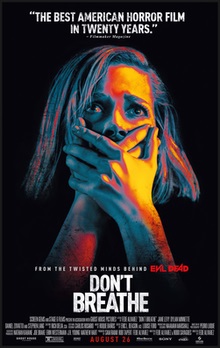 |
There are no monsters or demons in this film. None are needed. Some young, foolish crooks just picked the wrong house to break into. It's been a while since I've sat through a movie that kept me this much on edge. By the end, I was exhausted.
Don't Breathe is another Ghost House Pictures collaboration between writer/director Fede Alvarez and producer Sam Raimi. The two worked together previously on the 2013 Evil Dead re-make. Raimi is, of course, the man who brought us the original Evil Dead films, the Hercules and Xena television series, and the original Spiderman trilogy.
The premise of Don't Breathe is deceptively simple: Three small-time burglars take a chance on one big score - robbing the house of an old, blind man who lives alone and with no neighbors nearby. He was supposedly the recipient of a large cash settlement and our thieves believe he has the cash stashed in the house. (This part seemed like a stretch to me. Who keeps over a quarter of a million in cash in his house when he can't even make out the denominations? But it's a story.) The three manage to gain entry, though with more difficulty than expected. They really should have taken this as a sign. Things don't take long to turn bad and we are led through several twists and turns as bad shifts to increasingly horrific.
Stephen Lang shines as the blind man who is anything but helpless. As detestable as his character was in Avatar (2009), his character here has more subtle layers of evil and seems nearly as dangerous. Jane Levy (Evil Dead (2013)) and Dylan Minnette (Goosebumps (2015)), are also good as the not-entirely-terrible thieves who we experience the story through and have some sympathy for.
Don't Breathe follows a common formula. Jaws made people afraid of the ocean. Tremors made people afraid to set foot on the ground. Pitch Black made us fear the dark. Here, we fear making a sound. I caught myself several times throughout this film restricting my breathing, keeping still, lest the blind man with the quick movements and the steely grip get a hold of me. This is one of the most suspenseful movies I've seen. It's definitely worth seeing if you're up to it.
- JC
____________________
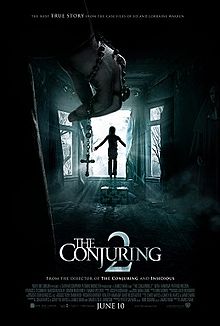 |
2016 hadn’t offered up anything particularly good in horror yet. So the return of director James Wan (Saw, Insidious, The Conjuring, and the very successful Furious 7) gave us something to be hopeful about.
The Conjuring 2 is a sequel to 2013’s The Conjuring, chronicling more of the paranormal investigations and perils of actual couple Lorraine and Ed Warren. This tale mostly focuses on their experiences investigating the Enfield Poltergeist case in London in 1977. The case was highly publicized at the time and attracted the attention of several paranormal investigators.
The story begins with Lorraine Warren (Vera Farmiga) conducting a séance in the Amityville home after the murders of 1974 and subsequent reports of paranormal events. Lorraine has a vision during the séance of the murders and also of a hideous demonic presence. Her husband and fellow investigator, Ed Warren (Patrick Wilson), helps her break away from the horrific experience. Afterwards, Lorraine tells Ed that they need to take some time away from this life for a while.
Meanwhile, a family in London, a single mother with four young children, starts to be plagued by strange occurrences in their home – objects moving by themselves, disturbing visions, sleepwalking of one of the girls, and eventually physical injuries in the form of bite marks. The case attracts the attention of the local media, paranormal investigators, and also the Catholic Church. A church representative reaches out to the Warren’s to determine whether or not the case is legitimate, at which point they would take action.
The Warrens make the journey to London and find themselves bonding with the youngest daughter, Janet Hodgson (Madison Wolfe), who has been the focal point of the haunting and the vessel through which the spirit has spoken. The case becomes a bit of a mystery. Who is doing the haunting? A ghost? Someone perpetrating a hoax? Something else?
Good points: The film is actually scary. It creates a feeling of dread early on and is able to re-create this consistently. Wan and his actors are also able to provide authentic performances and the relationships between the characters seem genuine. Farmiga and Wilson provide a good portrayal of a couple devoted to each other and also committed to their unusual mutual calling. The actors portraying the Hodgson family also seem to care for one another and their moments of both courage and terror are believable. This combination – characters we can care about in a situation with ever building suspense and dread – is what we hope for in a good horror film.
Quibbles: Unlike the first Conjuring film, I felt we got to see the “monster” a bit too much. As in Mama and Insidious, too good of a look at a supernatural entity starts to make it look “theatrical” instead of otherworldly. Also, the ending seemed a bit . . . fictional.
I recommend this movie since it will keep most people on the edges of their seats through the film. I suspect this second installment of the Warren’s adventures is more fictionalized then the first, but so what? These aren’t documentaries. I’m hoping for at least one more.
- JC
____________________
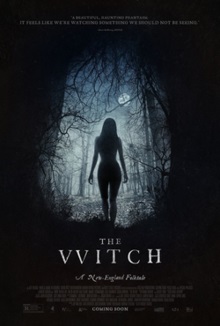 |
Don't be fooled. This isn't what I consider a horror film. It's a critically-acclaimed, award-winning film that is well directed by first-time director and writer Robert Eggers and contains several wonderful performances by its ensemble of actors. It is a very authentic-looking period drama set in 1630s New England depicting a deeply religious family struggling to survive in the wilderness while demonic forces close in around them. But it's not really a horror film.
The Witch has elements of a horror film - threatening supernatural elements, a building sense of dread, genuine peril to the characters - but these are over-shadowed by far by the re-creation of the old New England environment and the intra-family drama which often seems more threatening than anything that might be lurking in the woods.
Our primary character, Thomasin (Anya Taylor-Joy), is the eldest child of a couple who are expelled from the Puritan community over a disagreement over beliefs. (Apparently, the Puritans weren't devout enough for her father.) The father, William (Ralph Ineson), establishes a homestead a day's ride away at the edge of a great forest, with his pregnant wife, Katherine (Kate Dickie), Thomasin, son Caleb (Harvey Scrimshaw), and their two young twins, Mercy and Jonas. After the family has had a few months to settle in, things start going awry. While Thomasin is caring for her new baby brother, Samuel, the child mysteriously disappears. William's crops are failing and he is unsuccessful in hunting wild game. Things grow increasingly worse and even though there are dark forces at work, the breakdown of the family seems largely due to poor decisions, turning on each other, and trusting in desperate prayers to a God who has seemingly turned a deaf ear. This is less a horror story than a moral conundrum.
While I can appreciate the artistry behind this film, it mostly sends the viewer away with a profound sense of hopelessness and that's not what most of us go to the movies for. To illustrate the point, on Rottentomatoes.com, the critical consensus is 88% positive, while the audiences only gave 53% approval. This should tell you something.
One gets the feeling writer/director Eggers is trying to make some kind of point about religious piety in the face of a supernatural threat. But I was never quite able to grasp what he was trying to say. Was this a condemnation of Christianity made so bleak that Satan's path actually seems better? Was he trying to say that pride can be such an affront to God that He would let you and your family go down? Or was he so caught up in telling an old folk tale and making it look authentic that he didn't really think that much as to what any of it meant? Without hearing more from Eggers, I would have to lean towards that last one.
- JC